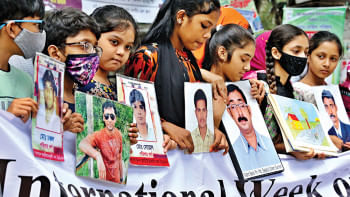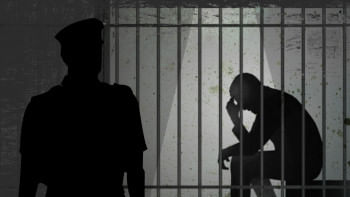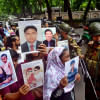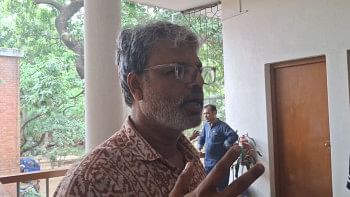Hasina’s regime and the systematic use of enforced disappearance

Enforced disappearance, the clandestine abduction or detention of individuals by state agents or their affiliates, stands among the most egregious violations of human rights and constitutes a crime against humanity. Under international law, crimes against humanity encompass systematic attacks against civilian populations, including murder, torture, and enforced disappearances. Unlike war crimes, these atrocities are not confined to periods of armed conflict and can be perpetrated even in times of peace.
It is now irrefutably evident that Sheikh Hasina's despotic regime (2009-2024) systematically weaponised enforced disappearance as a ruthless tool of political repression. Over the course of her 15-and-a-half-year rule, thousands of opposition activists, dissidents, and government critics were forcibly taken, leaving their families in perpetual anguish and uncertainty regarding their fate. The sheer brutality of these crimes not only inflicted profound sufferings upon the victims and their families, but also undermined the legal and constitutional bedrock of Bangladesh's already fragile democracy. Alarmingly, Bangladesh remains devoid of a legal framework to prosecute perpetrators of enforced disappearances, dismantle the entrenched culture of impunity, or implement the necessary legal and institutional reforms to ensure justice.
The magnitude of the crisis
Over the years, human rights organisations such as Odhikar and Mayer Dak have meticulously chronicled the staggering scale of enforced disappearances under the Hasina regime. Their exhaustive reports provide compelling evidence of how the country's security apparatuses—including the Rapid Action Battalion (Rab), the Detective Branch (DB) of police, the Directorate General of Forces Intelligence (DGFI), and the Counter-Terrorism and Transnational Crimes (CTTC) unit of police—abducted political dissidents, confined them in undisclosed detention facilities, and subjected them to torture, often spanning months or even years.
International human rights bodies, including Human Rights Watch (HRW) and Amnesty International, have corroborated these harrowing accounts. The UN Working Group on Enforced or Involuntary Disappearances has persistently called upon the Hasina regime to cease these egregious violations.
The US, in December 2021, imposed targeted sanctions on Rab and seven of its senior officials for their involvement in grave human rights violations. The sanctions cited over 600 enforced disappearances since 2009 and nearly 600 extrajudicial killings since 2018, underscoring the alarming extent of government-sponsored repression.
The crisis of enforced disappearances in Bangladesh transcends the realm of political oppression; it constitutes an unequivocal legal and moral indictment of the state's abject failure to uphold the most fundamental rights to life, liberty, and protection from government-sanctioned persecution.
Shocking revelations by the inquiry commission
In August 2024, the interim government established the Commission of Inquiry on Enforced Disappearances to investigate the grave human rights violations committed under the Hasina regime. Chaired by a High Court judge, the commission released its interim report in December last year, documenting over 3,500 cases. Among the 758 cases examined in detail, 204 victims (27 percent) remained unaccounted for. The report revealed the horrific nature of these atrocities as follows:
1) The crimes were systematically executed under a centralised command structure, with responsibilities carefully distributed among multiple security agencies. One agency carried out abductions, another detained the victims, and a third was tasked with either executing or releasing them.
2) Sheikh Hasina was personally involved in sanctioning enforced disappearances. In one documented case, a returned victim was explicitly informed that Hasina had granted him a "second chance," conditional upon his permanent withdrawal from politics, exile from Bangladesh, and return only with government approval.
3) A key tactic in enforced disappearances was the use of covert abductions without witnesses, made possible through the extensive use of state surveillance networks that tracked political opponents and dissenters.
4) Victims were held anywhere from days to several months or even years. Some were placed among legal detainees, while others were confined to Aynaghar, secret detention centres. There were several Aynaghar centres across the country, many of which were later dismantled.
5) Torture methods were barbaric. One victim's lips were sewn shut without anaesthesia. Another was subjected to electrocution on his ears and genitals, reflecting a methodical approach to psychological and physical torment.
6) In instances of extrajudicial executions, perpetrators deliberately endeavoured to erase the identities of the victims by discarding bodies into rivers or abandoning corpses on railway tracks to be gruesomely disfigured by passing trains.
7) Those who survived their ordeal were often implicated in false legal cases, entrapping them in prolonged legal battles designed to perpetuate their suffering and cripple them socially and financially.
8) High-level coordination occurred between Bangladeshi and Indian security forces in orchestrating disappearances. Notable cases included the abduction of Sukharanjan Bali from the Supreme Court premises in Bangladesh, the transfer of BNP leader Salahuddin Ahmed to the Indian authorities, and the interrogation of Hummam Quader Chowdhury by Hindi-speaking operatives.
The findings of the commission provide irrefutable evidence that enforced disappearances were not isolated incidents, but rather a deliberate and calculated government policy. These crimes were carried out with systematic precision, alleged foreign complicity, and a clear objective to eliminate political opposition and silence dissent under the guise of national security.
Failures of the legal system
Despite constitutional guarantees of fundamental rights—including the right to life (Article 32), protection from arbitrary detention (Article 33), and safeguards against torture (Article 35)—the judiciary in Bangladesh has persistently failed to uphold these protections. Habeas Corpus petitions filed by victims' families were routinely dismissed, with courts deferentially accepting the government's narrative rather than exercising their constitutional duty to safeguard individual liberties.
Although the Bangladesh Penal Code, 1860 criminalises abduction (Section 362) and unlawful confinement (Section 340), and the Code of Criminal Procedure, 1898 and the Torture and Custodial Death (Prevention) Act, 2013 explicitly prohibit torture and illegal detention, these legal provisions has proven to be largely ineffectual due to judicial inertia, systemic political interference, and a culture of impunity.
A fundamental flaw in Bangladesh's legal framework is that while the Penal Code criminalises abduction and unlawful confinement, it does not explicitly address enforced disappearance, a distinct crime characterised by the involvement of state apparatuses and the deliberate concealment of the victim's fate. Furthermore, legal provisions requiring government approval to prosecute public officials create a near-insurmountable legal barrier, effectively shielding perpetrators from accountability.
International legal frameworks
Enforced disappearances constitutes a flagrant violation of multiple provisions under international law. Such acts are explicitly prohibited under the Rome Statute of the International Criminal Court (ICC), the International Covenant on Civil and Political Rights (ICCPR), the Convention Against Torture (CAT), and the International Convention for the Protection of All Persons from Enforced Disappearance (ICPPED).
With the ratification of the ICPPED in August last year, Bangladesh is now legally bound to address enforced disappearances through comprehensive domestic legislation. This requires immediate legal and judicial reforms to dismantle entrenched impunity and establish a robust framework aligned with the ICPPED. The framework requires:
1) Crafting laws explicitly defining and penalising enforced disappearances, and holding superior officers and public officials accountable for ordering, authorising or failing to prevent such crimes.
2) Maintaining official detainee records, disclosing detention locations, ensuring legal representation and family access, and permitting independent facility monitoring.
3) Guaranteeing truth, justice, and full reparations, including restitution, compensation, rehabilitation, and non-recurrence safeguards.
4) Conducting thorough investigations, prosecuting offenders, and implementing systemic reforms to prevent future violations.
5) Facilitating cross-border investigations, extraditions, and prosecutions to ensure that perpetrators find no safe haven.
The path forward
To bring the perpetrators of enforced disappearance to justice, the first and most urgent step for Bangladesh is to immediately criminalise it under domestic law, fully aligning with the provisions of the ICPPED.
Second, justice demands that all those complicit—ranging from the highest political figures to security personnel, and those who facilitated these crimes—be held to account. The security agencies involved—the primary instruments of repression—must either be dismantled entirely or subjected to a thorough purge, ensuring the removal of all individuals implicated in these grave human rights violations.
Third, the destruction and tampering of evidence related to these heinous crimes must be halted immediately. It must be recognised that the torture centres constitute crime scenes, and any interference with evidence—whether through alteration, destruction, concealment or fabrication—is a criminal act. Such actions obstruct justice, distort investigations, and shield perpetrators from accountability.
Fourth, Bangladesh must establish a special tribunal dedicated to prosecuting those responsible for enforced disappearances, drawing upon international precedents, such as Argentina's prosecution of military officials involved in enforced disappearances during the Dirty War (1976-1983).
Finally, the horrors perpetrated under Sheikh Hasina's regime cannot be erased from historical memory. The truth has emerged, and with it the moral and legal imperative to deliver justice. A powerful example must be set so that it becomes inconceivable for any future government to wield terror as an instrument of governance. Those silenced by enforced disappearance can no longer speak; it is the duty of the living to demand justice in their name.
Dr CAF Dowlah is chair and executive director at the Bangladesh Institute of Policy Studies (BIPS) and a visiting scholar at the University of Miami School of Law in the US.
Views expressed in this article are the author's own.
Follow The Daily Star Opinion on Facebook for the latest opinions, commentaries and analyses by experts and professionals. To contribute your article or letter to The Daily Star Opinion, see our guidelines for submission.

 For all latest news, follow The Daily Star's Google News channel.
For all latest news, follow The Daily Star's Google News channel. 










Comments